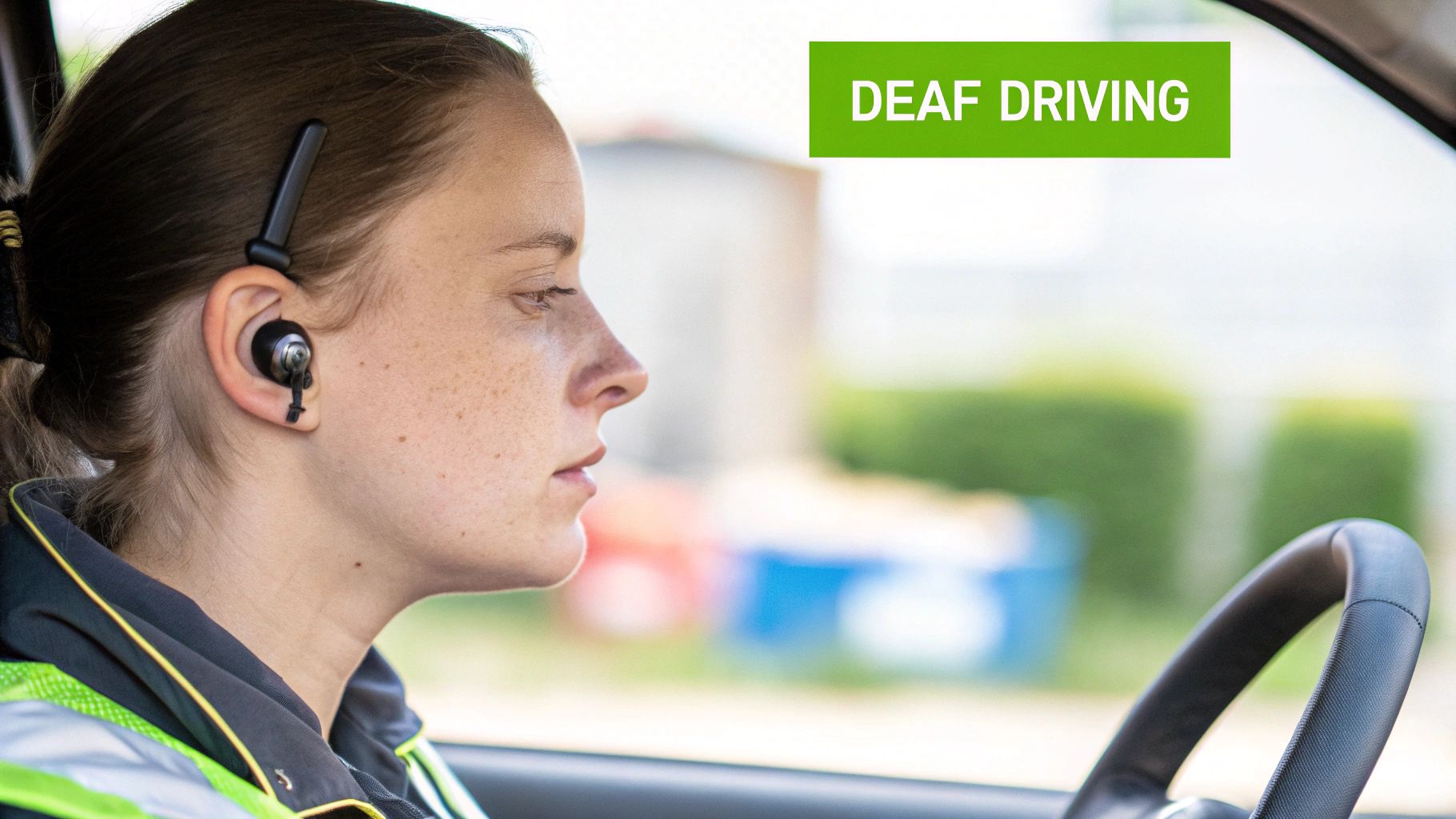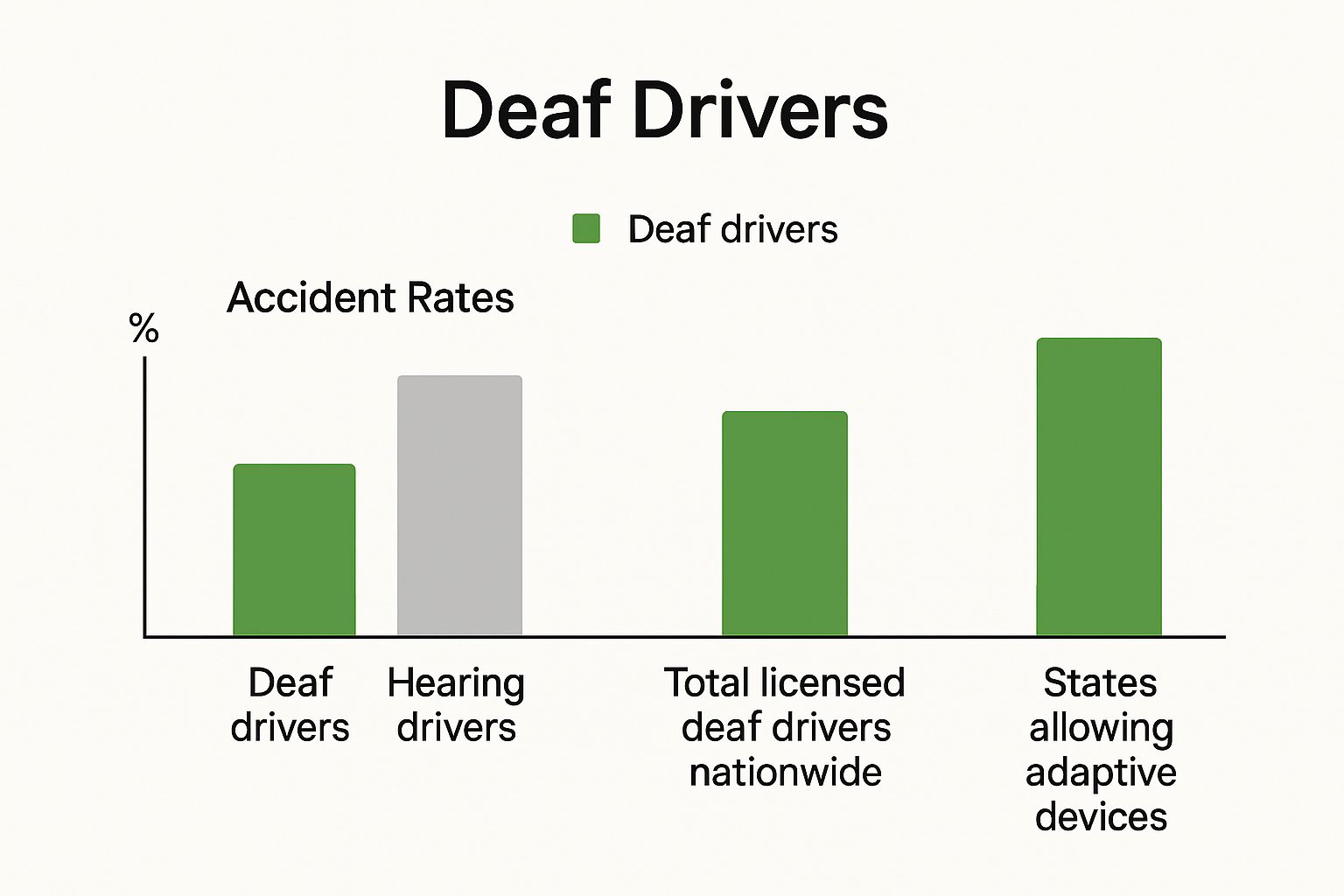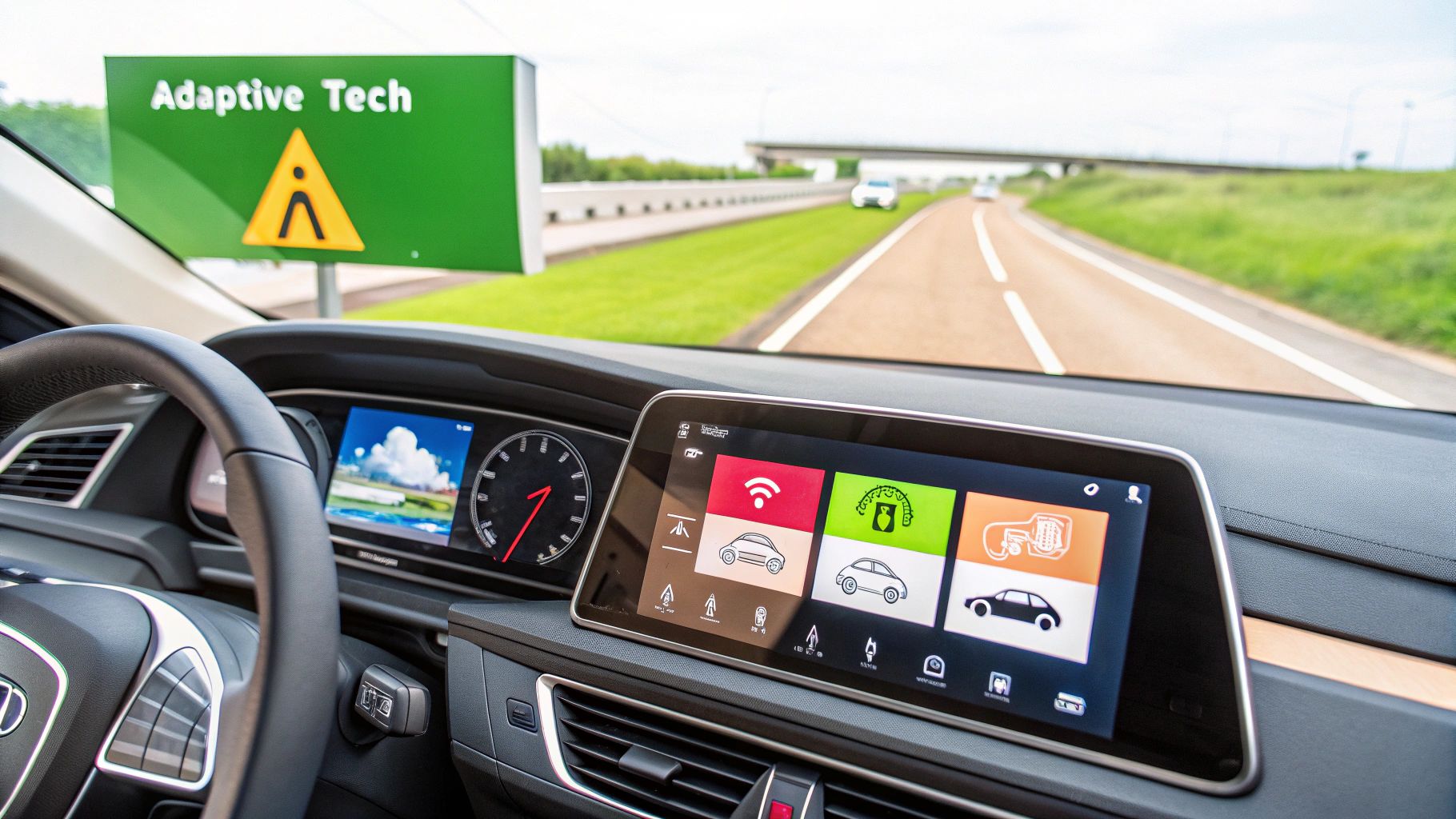Your Legal Right To Drive: What UK Law Actually Says

Can deaf people drive in the UK? Absolutely. The right to drive for deaf individuals is well-established and protected under UK law. This means that if you are deaf or hard of hearing, you have the same opportunities to obtain and hold a driving licence as anyone else.
This legal protection is a result of long-standing progress in disability rights and the recognition that deafness does not inherently affect driving ability.
The Equality Act 2010 is the cornerstone of this right. This important legislation prevents discrimination against individuals with disabilities, including deafness, in many areas of life, such as access to driving licences. The Driver and Vehicle Licensing Agency (DVLA) cannot refuse a licence solely based on deafness.
There are no special hearing tests or requirements specifically for deaf individuals. This reflects the UK's commitment to fairness and equal opportunity. Learn more about your rights as a deaf driver here.
DVLA Policies and Deaf Drivers
The DVLA's own policies support this legal framework. The DVLA acknowledges that deaf drivers can be just as capable, and often even more so, than hearing drivers. Many deaf individuals develop enhanced visual awareness and other compensating skills that can actually improve their driving.
The DVLA focuses on assessing overall driving competency rather than imposing unnecessary restrictions based on hearing.
Legal Precedents and Your Protection
The right for deaf people to drive wasn't always so straightforward. Over time, key legal cases and the persistent work of advocacy groups have shaped current policy, securing the rights enjoyed today.
These legal wins have set important precedents, solidifying the illegality of discrimination against deaf drivers. You have legal options if you face any obstacles or prejudice related to your deafness and your driving rights.
What This Means for You
This legal framework provides a solid foundation for aspiring deaf drivers in the UK. You can pursue your driving goals knowing your rights are protected. You can access the same opportunities as everyone else, without facing unfair barriers or discrimination. The law is on your side.
Getting Your Licence: Real Steps That Actually Work

Ready to embark on your driving journey? This section outlines the process of obtaining a driving licence in the UK, with a focus on the experience for deaf learners. It's a multi-stage process, but achievable with the right preparation.
The Theory Test: Accommodations and Support
The first step is the theory test. Accommodations are available to ensure accessibility for all. You can request a British Sign Language (BSL) interpreter or take the test in written format. Extra time can also be requested to ensure you have sufficient time to comprehend and answer the questions. Contact the DVSA well in advance of your test date to make the necessary arrangements.
Finding the Right Instructor: Key Questions to Ask
Selecting the right instructor is crucial. Seek out driving schools with experience teaching deaf students or instructors proficient in BSL. If BSL isn't feasible, clear communication strategies are essential.
Here are some key questions to ask potential instructors:
- What experience do you have teaching deaf learners?
- How will we communicate effectively during lessons?
- Are you familiar with the modified practical driving test procedures?
For those considering an intensive course, this article may be helpful: How to master intensive driving courses.
Preparing for the Practical Test: Modifications and Strategies
The practical test follows the same format as for hearing drivers, with some potential modifications. For example, you might use pre-agreed visual signals with the examiner. Discuss these adjustments with your instructor to ensure you're well-prepared.
Learning to Drive: Communication is Key
Clear communication with your instructor is paramount throughout your lessons. This could involve using a whiteboard, pre-arranged hand signals, or lip reading. Experiment with different methods to find what works best. Openly communicate any specific learning needs or challenges you encounter.
Tips from Experienced Deaf Drivers
Many deaf drivers develop heightened visual awareness, regularly checking mirrors and scanning the road. This compensates for the absence of auditory cues. Remember, you're not alone. Many deaf drivers have successfully obtained their licences in the UK. Connecting with online deaf driving communities or seeking mentorship can provide valuable support and boost your confidence.
The Safety Truth: What Research Actually Shows
Tired of outdated assumptions about deaf drivers? Let's clear the air and look at the facts. Contrary to popular belief, deaf individuals can be exceptionally safe drivers. They often compensate for their lack of hearing with enhanced visual awareness and heightened peripheral vision, constantly scanning their surroundings for potential hazards. Want to learn more? Check out this insightful article: How do deaf people drive?
This heightened visual awareness isn’t just anecdotal; it's supported by research.
Enhanced Visual Awareness: A Compensating Strength
Numerous studies show that deaf individuals often develop superior peripheral vision and faster reaction times to visual stimuli. This allows them to anticipate and react to potential hazards more effectively than hearing drivers, who may rely more on auditory cues. For example, a deaf driver might notice a pedestrian stepping off the curb sooner than a hearing driver, due to their enhanced visual scanning.
Modern Technology: Leveling the Playing Field
Advancements in vehicle technology are making roads safer for everyone, including deaf drivers. Features like blind-spot monitoring systems, lane departure warnings, and rearview cameras provide visual cues that benefit all drivers.
These technological advancements help mitigate potential risks and empower deaf drivers to navigate roads safely and confidently.

This infographic presents data comparing accident rates between deaf and hearing drivers, the total number of licensed deaf drivers in the UK, and the availability of adaptive driving devices. It helps to debunk some common myths surrounding deaf drivers.
The following table further clarifies these misconceptions:
To further illustrate the reality of deaf drivers' safety, let's examine some common misconceptions.
Deaf Driver Safety: Facts vs Fiction
| Common Myth | Reality | Supporting Evidence |
|---|---|---|
| Deaf drivers are more dangerous than hearing drivers. | Accident rates for deaf drivers are often comparable to, or even lower than, those of hearing drivers. | Data presented in the infographic above demonstrates this. |
| Deaf drivers cannot be aware of emergency vehicles. | Visual cues, like flashing lights, are readily apparent to deaf drivers. Increased visual awareness compensates for the lack of sirens. | Driving instructors emphasize visual awareness training for deaf drivers. |
| Deaf drivers struggle with navigation. | Modern GPS systems provide clear visual directions, making navigation accessible for all. | Wide availability and usage of GPS technology support this fact. |
As this table clearly demonstrates, many common myths about deaf drivers simply don't hold up against the facts. Deafness does not inherently make someone a less safe driver. The combination of enhanced visual skills, modern vehicle technology, and adaptive driving devices allows deaf individuals to navigate the roads safely and effectively.
Practical Strategies That Make Driving Easier

Beyond simply holding a driving license, deaf individuals in the UK utilize practical strategies and adaptations to ensure a smoother and safer driving experience. These methods range from modifying their vehicles to implementing effective communication techniques and utilizing available technology. This focus is not about special privileges, but rather about promoting equal access and safety for all on the road.
Vehicle Modifications: Enhancing Your Driving Experience
While not legally required, certain vehicle modifications can significantly benefit deaf drivers. For example, enhanced mirror systems can dramatically improve visibility by expanding the driver's field of view and minimizing blind spots. This is particularly useful for observing other vehicles and pedestrians.
Visual alert systems for emergency vehicles are also becoming more readily available. These systems typically employ flashing lights or vibrations to notify the driver of sirens or horns, providing critical information they might otherwise miss. These adaptations offer added safety and awareness while driving.
Communication Strategies: Navigating Interactions On The Road
Clear communication is crucial in various driving scenarios. During a police stop, for instance, a pre-written card explaining your deafness can prevent confusion and facilitate communication with the officer. Similarly, if a breakdown occurs, using text messages or mobile apps to contact recovery services can simplify the process.
For emergency situations, carrying a notepad and pen can be essential. This simple tool allows for direct communication with other drivers or emergency personnel, ensuring clarity and efficiency when it matters most. These strategies empower deaf drivers to handle unforeseen circumstances with confidence.
Leveraging Technology and Apps: Staying Informed and Connected
Technology offers a variety of tools designed to assist deaf drivers. In-car systems that convert audio alerts into visual cues are becoming increasingly prevalent. Smartphone apps can also improve road awareness by delivering real-time traffic updates, hazard warnings, and alternative route suggestions. Some apps even provide visual notifications for approaching emergency vehicles.
Dedicated roadside assistance apps also allow for text-based communication with breakdown services, eliminating the need for phone calls and making assistance readily available. These technological advancements promote safety, enhance awareness, and build confidence on the road.
Mastering Motorway Driving and Weather Conditions: Advanced Techniques
Motorway driving presents unique challenges, and experienced deaf drivers often develop specific techniques for enhanced safety. For instance, using the left-hand lane whenever practical reduces the need for frequent lane changes and improves anticipation of merging traffic, contributing to a smoother, less stressful experience.
Adapting to varying weather conditions also requires careful attention. In heavy rain or fog, increasing following distances and reducing speed are vital for all drivers, especially those relying predominantly on visual cues. These proactive measures ensure safe driving regardless of weather. These strategies, developed and refined by experienced deaf drivers, demonstrate that deafness does not prevent anyone from confidently navigating the UK road network.
How We Got Here: The Journey To Equal Driving Rights
Understanding your current freedoms as a deaf driver in the UK requires appreciating the historical journey of deaf rights in Britain. This journey showcases the significant strides made toward inclusion and equality, particularly concerning driving privileges.
Early Advocacy and Education: Laying the Groundwork
The foundation for these advancements can be traced to the 18th century. In 1760, Thomas Braidwood, a Scottish educator, founded Britain's first school for the deaf. His pioneering approach, which combined sign language with other communication methods, profoundly influenced the development of British Sign Language (BSL). This focus on education and communication set the stage for later progress in deaf rights, including driving access. Learn more about deaf history here.
20th Century Progress: A Shift in Perception
The 20th century saw substantial progress in deaf rights advocacy. Organizations like the Royal National Institute for Deaf People (RNID) played a vital role in challenging discriminatory practices and advocating for the inclusion of deaf individuals in all facets of society. This advocacy included the right to drive, with campaigns highlighting the capability and safety of deaf drivers. These initiatives helped change public opinion and prepare the ground for legislative changes.
Landmark Legislation: Formalising Equality
This sustained advocacy led to the official recognition of BSL as a minority language in 2003. This momentous decision further integrated deaf individuals into British society, breaking down barriers to communication and participation.
The Equality Act 2010 expanded on this progress, offering comprehensive legal safeguards against discrimination for people with disabilities, including deafness. This act explicitly protects the right of deaf people to drive, ensuring they are not unjustly excluded based on their hearing ability. This legal structure confirmed the concept of equal access and solidified the driving rights of deaf individuals in the UK.
The Impact of Grassroots Movements: Changing Hearts and Minds
Beyond official legislation, grassroots movements and community activism have been key in shifting public perceptions of deaf drivers. Personal stories of resolve and lived experiences have demonstrated the competence and safety of deaf individuals behind the wheel, dispelling outdated misconceptions. This evolving understanding has fostered a more inclusive environment for deaf people to exercise their driving rights, free from prejudice and baseless concerns. This historical progression reveals that these rights are not simply granted but rather hard-earned triumphs achieved through centuries of advocacy, persistence, and societal transformation.
Your Support Network: Resources That Actually Help
Learning to drive as a deaf person in the UK can present unique challenges. Fortunately, a robust network of resources and support systems exists to assist you throughout your driving journey. These resources offer practical help, build confidence, and ensure you’re well-equipped to handle any obstacles.
Specialist Driving Schools and Instructors
Across the UK, several driving schools specialize in teaching deaf learners. These schools often employ instructors fluent in British Sign Language (BSL) or skilled in using visual aids and other communication methods. Finding an instructor who understands your needs can greatly improve your learning experience. For some helpful tips for new drivers, check out this resource on driving lessons for beginners.
Insurance and Breakdown Services
Certain insurance companies and breakdown services cater specifically to the needs of deaf drivers. They offer accessible communication options, such as text messaging or mobile apps, for reporting accidents or requesting roadside assistance. These services ensure you can access help quickly and efficiently, regardless of the situation.
Online Communities and Peer Support
Online communities provide valuable platforms for deaf drivers to connect and share experiences. These forums foster a sense of belonging and offer a space to exchange advice. More experienced deaf drivers can share practical tips on various topics, from driving test modifications to helpful vehicle adaptations.
Government Resources and Advocacy Groups
Numerous government resources and advocacy organizations in the UK support the rights of deaf and hard of hearing individuals. These groups actively work to eliminate discrimination and promote equal access. Organizations like the Royal National Institute for Deaf People (RNID) offer specialized resources and support tailored to the deaf community. While precise statistics on deaf drivers in the UK are limited, the official recognition of BSL as a minority language demonstrates a commitment to inclusivity. The RNID plays a crucial role in providing resources and advocating for the deaf and hard of hearing. You can learn more about Deafness in the United Kingdom.
BSL Interpreters and Accessible Communication
Accessing BSL interpreters for driving-related appointments, such as theory tests or meetings with the DVLA (Driver and Vehicle Licensing Agency), is essential for clear communication. This readily available service simplifies the licensing process and other administrative procedures. Skilled interpreters bridge communication gaps and empower you to effectively advocate for your needs.
This comprehensive support network provides a solid foundation for deaf individuals pursuing their driving goals in the UK. By utilizing these resources, you can build confidence, overcome challenges, and experience the freedom and independence that comes with driving.
What's Coming Next: Technology Changing Everything
The future of driving for deaf individuals is looking increasingly promising, thanks to the rapid advancements we're seeing in automotive technology. These innovations aren't just about accessibility; they're making driving safer and more enjoyable for everyone.
Heads-Up Displays and Visual Alerts
Heads-up displays (HUDs) are becoming a more common feature in modern vehicles. HUDs project essential information like speed and navigation directions directly onto the windshield, keeping it within the driver's line of sight. This is especially helpful for deaf drivers, allowing them to stay informed without having to look away from the road.
Furthermore, advanced vibration-based alert systems are being integrated into car seats and steering wheels. These systems can alert drivers to potential dangers, such as approaching emergency vehicles, through tactile feedback. This effectively replaces auditory alerts, providing crucial safety information in a way that deaf drivers can readily perceive.
Smartphone Integration and Visual Communication
Smartphone integration is another area of exciting development. Apps can now connect with a vehicle's systems to deliver visual notifications for everything from traffic updates to incoming messages. This connectivity paves the way for enhanced visual communication systems, improving the overall driving experience for deaf individuals. Some apps can even translate audio alerts into visual cues, effectively bridging the gap between sound and sight.
Autonomous Vehicles: Accessibility From the Ground Up
The development of autonomous vehicles is also taking accessibility into account from the very beginning. Engineers are working hard to ensure that self-driving cars cater to the needs of all users, including those who are deaf. This forward-thinking approach has the potential to revolutionize transportation, making it truly inclusive and accessible for everyone.
Current Innovations Available Now
Many of these advancements aren't just futuristic concepts; they're available today. Leading car manufacturers are collaborating with accessibility advocates to create truly inclusive driving experiences. This partnership is resulting in innovative features specifically designed for deaf drivers. These features include visual indicators for emergency vehicle sirens and haptic feedback systems for lane departure warnings.
The following table highlights some key emerging technologies and their benefits for deaf drivers:
Emerging Technologies for Accessible Driving
| Technology | Availability | Benefits for Deaf Drivers | Expected Timeline |
|---|---|---|---|
| Heads-up Displays (HUDs) | Now | Projects vital information onto the windscreen | Increasingly standard |
| Vibration-Based Alerts | Now | Tactile feedback for hazard warnings | Wider adoption expected |
| Smartphone Integration/Visual Communication Systems | Now | Visual notifications, audio-to-visual translation | Continuous improvement |
| Autonomous Vehicles with Accessibility Features | Developing | Inclusive transportation solutions | Next 5-10 years |
This focus on accessibility represents a significant shift in the automotive industry. It highlights a commitment to ensuring that everyone, regardless of their hearing ability, can enjoy the freedom and independence that driving provides.
Ready to experience the freedom and independence of driving? Fast Pass Driving Courses offers intensive and semi-intensive driving lessons throughout the UK, tailored to individual learning styles and needs. Visit their website to book your course today and begin your driving journey.

